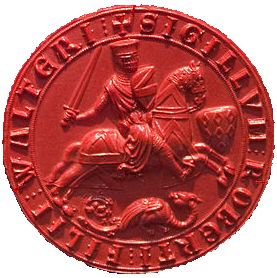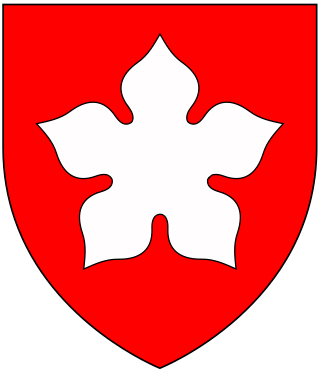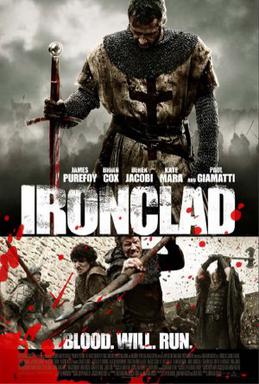
Year 1217 (MCCXVII) was a common year starting on Sunday of the Julian calendar.

William Marshal, 1st Earl of Pembroke, also called William the Marshal, was an Anglo-Norman soldier and statesman. He served five English kings—Henry II, his sons the "Young King" Henry, Richard I, and John, and finally John's son Henry III.

Louis VIII, nicknamed The Lion, was King of France from 1223 to 1226. As prince, he invaded England on 21 May 1216 and was excommunicated by a papal legate on 29 May 1216. On 2 June 1216, Louis was proclaimed "King of England" by rebellious barons in London, though never crowned. He soon seized half the English kingdom but was eventually defeated by the English and after the Treaty of Lambeth, was paid 10,000 marks, pledged never to invade England again, and was absolved of his excommunication.

Roger Bigod was the son of Hugh Bigod, 1st Earl of Norfolk and his first wife, Juliana de Vere. Although his father died in 1176 or 1177, Roger did not succeed to the earldom of Norfolk until 1189 for his claim had been disputed by his stepmother for her sons by Earl Hugh in the reign of Henry II. King Richard I confirmed him in his earldom and other honours, and also sent him as an ambassador to France in the same year. Roger inherited his father's office as royal steward. He took part in the negotiations for the release of Richard from prison, and after the king's return to England became a justiciar.

William Longespée, 3rd Earl of Salisbury was an Anglo-Norman nobleman, primarily remembered for his command of the English forces at the Battle of Damme and for remaining loyal to his half-brother, King John. His nickname "Longespée" is generally taken as a reference to his great physical height and the oversize weapons that he used.

The First Barons' War (1215–1217) was a civil war in the Kingdom of England in which a group of rebellious major landowners led by Robert Fitzwalter waged war against King John of England. The conflict resulted from King John's disastrous wars against King Philip II of France, which led to the collapse of the Angevin Empire, and John's subsequent refusal to accept and abide by the Magna Carta, which John had sealed on 15 June 1215.

William Marshal, 2nd Earl of Pembroke was a medieval English nobleman and was one of Magna Carta sureties. He fought during the First Barons' War and was present at the Battle of Lincoln (1217) alongside his father William Marshal, 1st Earl of Pembroke, who led the English troops in that battle. He commissioned the first biography of a medieval knight to be written, called L'Histoire de Guillaume le Mareschal, in honour of his father.

Robert Fitzwalter was one of the leaders of the baronial opposition against King John, and one of the twenty-five sureties of Magna Carta. He was feudal baron of Little Dunmow, Essex and constable of Baynard's Castle, in London, to which was annexed the hereditary office of castellan and chief knight banneret of the City of London. Part of the official aristocracy created by Henry I and Henry II, he served John in the wars in Normandy, in which he was taken prisoner by King Philip II of France and forced to pay a heavy ransom.

Ranulf de Blondeville, 6th Earl of Chester and 1st Earl of Lincoln, known in some references as the 4th Earl of Chester, was one of the "old school" of Anglo-Norman barons whose loyalty to the Angevin dynasty was consistent but contingent on the receipt of lucrative favours. He has been described as "almost the last relic of the great feudal aristocracy of the Conquest".

Sir Falkes de Bréauté was an Anglo-Norman soldier who earned high office by loyally serving first King John and later King Henry III in the First Barons' War. He played a key role in the Battle of Lincoln Fair in 1217. He attempted to rival Hubert de Burgh, and as a result fell from power in 1224. His "heraldic device" is now popularly said to have been a griffin, although his coat of arms as depicted by Matthew Paris in his Chronica Majora was Gules, a cinquefoil argent.

The Saintonge War was a feudal dynastic conflict that occurred between 1242 and 1243. It opposed Capetian forces supportive of King Louis IX's brother Alphonse, Count of Poitiers and those of Hugh X of Lusignan, Raymond VII of Toulouse and Henry III of England. The last hoped to regain the Angevin possessions lost during his father's reign. Saintonge is the region around Saintes in the centre-west of France and is the place where most of fighting occurred.

Nicola de la Haie, of Swaton in Lincolnshire, was an English landowner and administrator who inherited from her father not only lands in both England and Normandy but also the post of hereditary constable of Lincoln Castle. On her own, she twice defended the castle against prolonged sieges. After the death of her second husband in 1214, she continued to hold the castle until she retired on grounds of old age in 1226.
The Battle of Sandwich, also called the Battle of Dover took place on 24 August 1217 as part of the First Barons' War. A Plantagenet English fleet commanded by Hubert de Burgh attacked a Capetian French fleet led by Eustace the Monk and Robert of Courtenay off Sandwich, Kent. The English captured the French flagship and most of the supply vessels, forcing the rest of the French fleet to return to Calais.
Events from the 1210s in England.
William of Cassingham was a country squire of Cassingham in Kent at the time of the First Barons' War. During that conflict, he raised a guerrilla force of archers which opposed the otherwise total occupation of the south-east by Prince Louis of France. A contemporary chronicler, Roger of Wendover, wrote of him:
A certain youth, William by name, a fighter and a loyalist [to King John] who despised those who were not, gathered a vast number of archers in the forests and waste places [of the Kent and Sussex Weald], all of them men of the region, and all the time they attacked and disrupted the enemy, and as a result of their intense resistance many thousands of Frenchmen were slain. Roger of Wendover, Flores Historiarum, II. 182.

Ironclad is a 2011 British action adventure war film directed by Jonathan English. Written by English and Erick Kastel, based on a screenplay by Stephen McDool, the cast includes James Purefoy, Brian Cox, Kate Mara, Paul Giamatti, Vladimir Kulich, Mackenzie Crook, Jason Flemyng, Derek Jacobi, and Charles Dance. The film chronicles the siege of Rochester Castle by King John in 1215. The film was shot entirely in Wales in 2009 and produced on a budget of $25 million.

The Battle of Monmouth took place on 25 November 1233, the feast day of St Catherine, between forces loyal to Henry III, King of England, and those of Richard Marshal, Earl of Pembroke and Lord Marshal of England, who had formed an alliance with the Welsh prince Llywelyn ap Iorwerth and his supporter Owain ap Gruffydd, a grandson of Rhys of Deheubarth.
Stephen Devereux was a powerful Marcher Lord, and held Lyonshall Castle controlling an important approach to the border of Wales. As a key member of William Marshal, 1st Earl of Pembroke retinue, he played a significant role in the Earl's support of King John during the First Barons' War, and during the minority of Henry III.

The Capetian–Plantagenet rivalry was a series of conflicts and disputes that covered a period of 100 years (1159–1259) during which the House of Capet, rulers of the Kingdom of France, fought the House of Plantagenet, rulers of the Kingdom of England, over the Plantagenet-held Angevin Empire which at it's peak covered around half of the territory within France. Some historians refer to this series of events as the "First Hundred Years' War".
Thomas, Count of Perche, was the son of Geoffrey III, Count of Perche, and Matilda of Saxony, daughter of Henry the Lion, Duke of Saxony and Bavaria, and Matilda of England. He died young.















